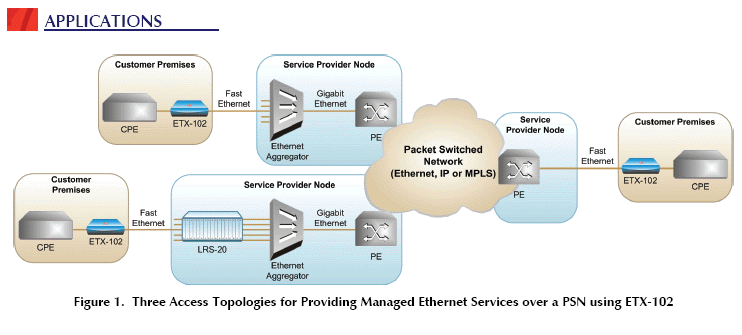
RAD
ETX-102 Fast Ethernet Network Termination Unit
Smart Demarcation Point Between the Service Provider and Customer Networks
Key-Points of the RAD ETX-102 Fast Ethernet Network Termination Unit
ETX-102 is a network termination unit (NTU) owned and operated by the service provider and
installed at the customer premises. The RAD ETX-102 serves as clear demarcation between the user and operator
networks.
Providing monitoring and diagnostic as well as QoS capabilities, the RAD ETX-102 focuses on the service and
allows the service provider to achieve end-to-end rather than edge-to-edge service control.
IP address, IP mask and default gateway can be automatically obtained using DHCP.
ETX-102 ETHERNET CAPABILITIES
ETX-102 features an internal bridge, operating in the VLAN-aware and VLAN-unaware modes.VLAN stacking can be used for traffic separation between different users or services, by defining a Service VLAN ID per customer or service. When VLAN stacking is used, a Service VLAN tag is added to the user traffic and removed from network traffic. Both Service VLAN ID and Service VLAN priority can be defined.
The RAD ETX-102 provides a user-configurable fault propagation mechanism. When a link failure is detected at the network port, ETX-102 optionally shuts down any of the user ports until the network link is restored.
RAD ETX-102 QoS
Different levels of service require different QoS types to be provided end-to-end. QoS can be defined per subscriber as well as per service. QoS has two aspects: rate limitation and traffic prioritization.Hierarchical rate limitation allows defining peak traffic rate per user, per service or per traffic aggregate. This allows the user to maximize bandwidth utilization.
In order to perform user traffic prioritization, ETX-102 supports up to four separate queues, which handle traffic with different service demands, such as real-time traffic, premium data or best-effort data. In case of congestion, the relevant service already receiving higher priority at the customer premises. Traffic can be classified dynamically and mapped to different priority queues according to VLAN priority, DSCP, or ToS. Appropriate QoS can be achieved without customer marking, by mapping different services and different user ports (port-based priority).
ETX-102 MANAGEMENT CAPABILITIES
The RAD ETX-102 can be managed using different ports and applications:Local management via an ASCII terminal connected to the RS-232 port
Remote inband management via user or network ports. Remote management is performed using Telnet, Web browser or RADview Lite, RAD’s SNMP-based management system.
Management traffic can be separated from user data by creating a dedicated management VLAN.
Up to three different stations can manage ETX-102 simultaneously, enabling monitoring the network status from different locations.
ETX-102 MEF 9 COMPLIANCE
ETX-102 is certified by Metro Ethernet Forum for EPL services (MEF 9).
TYPICAL APPLICATIONS FOR THE ETX-102 Fast Ethernet Network Termination Unit
Providing access to packet-switched networks (Ethernet, IP/MPLS), as well as next-generation
SDH/SONET backbones over Ethernet, using standard fiber optic interface. Access to legacy
networks is possible when the edge devices include tributary Ethernet ports (see Figure 1).
ETX-102 can be used for site-to-site connectivity (E-line), and for multiple site connectivity (E-LAN),
depending on network topology.
Features of the RAD ETX-102 Fast Ethernet Network Termination Unit included:
Smart demarcation point between the service provider and customers’ private networks
One or four user and one network Fast Ethernet ports
VLAN-aware and VLAN-unaware bridging
Traffic prioritization for different service levels
Traffic classification and priority mapping according to VLAN priority, ToS, DSCP or physical port
Hierarchical QoS for defining rate limitation per service and per traffic aggregate for maximizing
bandwidth utilization
VLAN stacking (double tagging or QinQ) for transparent end-to-end services
Diagnostics include port loopbacks and ICMP ping
Extended management capabilities:
Local out-of-band management via the ASCII terminal port
Remote inband management via the network port
Remote software download and configuration download/upload
Plug-and-play using DHCP client
Fault propagation of the network link failure conditions to the user port
MEF 9 certified


